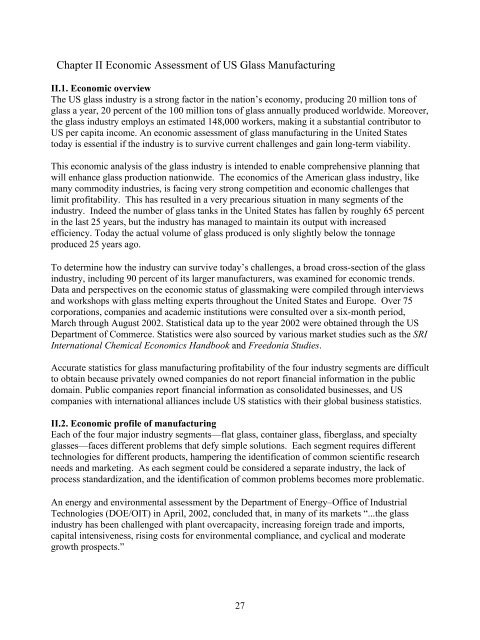Glass Melting Technology: A Technical and Economic ... - OSTI
Glass Melting Technology: A Technical and Economic ... - OSTI
Glass Melting Technology: A Technical and Economic ... - OSTI
You also want an ePaper? Increase the reach of your titles
YUMPU automatically turns print PDFs into web optimized ePapers that Google loves.
Chapter II <strong>Economic</strong> Assessment of US <strong>Glass</strong> Manufacturing<br />
II.1. <strong>Economic</strong> overview<br />
The US glass industry is a strong factor in the nation’s economy, producing 20 million tons of<br />
glass a year, 20 percent of the 100 million tons of glass annually produced worldwide. Moreover,<br />
the glass industry employs an estimated 148,000 workers, making it a substantial contributor to<br />
US per capita income. An economic assessment of glass manufacturing in the United States<br />
today is essential if the industry is to survive current challenges <strong>and</strong> gain long-term viability.<br />
This economic analysis of the glass industry is intended to enable comprehensive planning that<br />
will enhance glass production nationwide. The economics of the American glass industry, like<br />
many commodity industries, is facing very strong competition <strong>and</strong> economic challenges that<br />
limit profitability. This has resulted in a very precarious situation in many segments of the<br />
industry. Indeed the number of glass tanks in the United States has fallen by roughly 65 percent<br />
in the last 25 years, but the industry has managed to maintain its output with increased<br />
efficiency. Today the actual volume of glass produced is only slightly below the tonnage<br />
produced 25 years ago.<br />
To determine how the industry can survive today’s challenges, a broad cross-section of the glass<br />
industry, including 90 percent of its larger manufacturers, was examined for economic trends.<br />
Data <strong>and</strong> perspectives on the economic status of glassmaking were compiled through interviews<br />
<strong>and</strong> workshops with glass melting experts throughout the United States <strong>and</strong> Europe. Over 75<br />
corporations, companies <strong>and</strong> academic institutions were consulted over a six-month period,<br />
March through August 2002. Statistical data up to the year 2002 were obtained through the US<br />
Department of Commerce. Statistics were also sourced by various market studies such as the SRI<br />
International Chemical <strong>Economic</strong>s H<strong>and</strong>book <strong>and</strong> Freedonia Studies.<br />
Accurate statistics for glass manufacturing profitability of the four industry segments are difficult<br />
to obtain because privately owned companies do not report financial information in the public<br />
domain. Public companies report financial information as consolidated businesses, <strong>and</strong> US<br />
companies with international alliances include US statistics with their global business statistics.<br />
II.2. <strong>Economic</strong> profile of manufacturing<br />
Each of the four major industry segments—flat glass, container glass, fiberglass, <strong>and</strong> specialty<br />
glasses—faces different problems that defy simple solutions. Each segment requires different<br />
technologies for different products, hampering the identification of common scientific research<br />
needs <strong>and</strong> marketing. As each segment could be considered a separate industry, the lack of<br />
process st<strong>and</strong>ardization, <strong>and</strong> the identification of common problems becomes more problematic.<br />
An energy <strong>and</strong> environmental assessment by the Department of Energy–Office of Industrial<br />
Technologies (DOE/OIT) in April, 2002, concluded that, in many of its markets “...the glass<br />
industry has been challenged with plant overcapacity, increasing foreign trade <strong>and</strong> imports,<br />
capital intensiveness, rising costs for environmental compliance, <strong>and</strong> cyclical <strong>and</strong> moderate<br />
growth prospects.”<br />
27

















